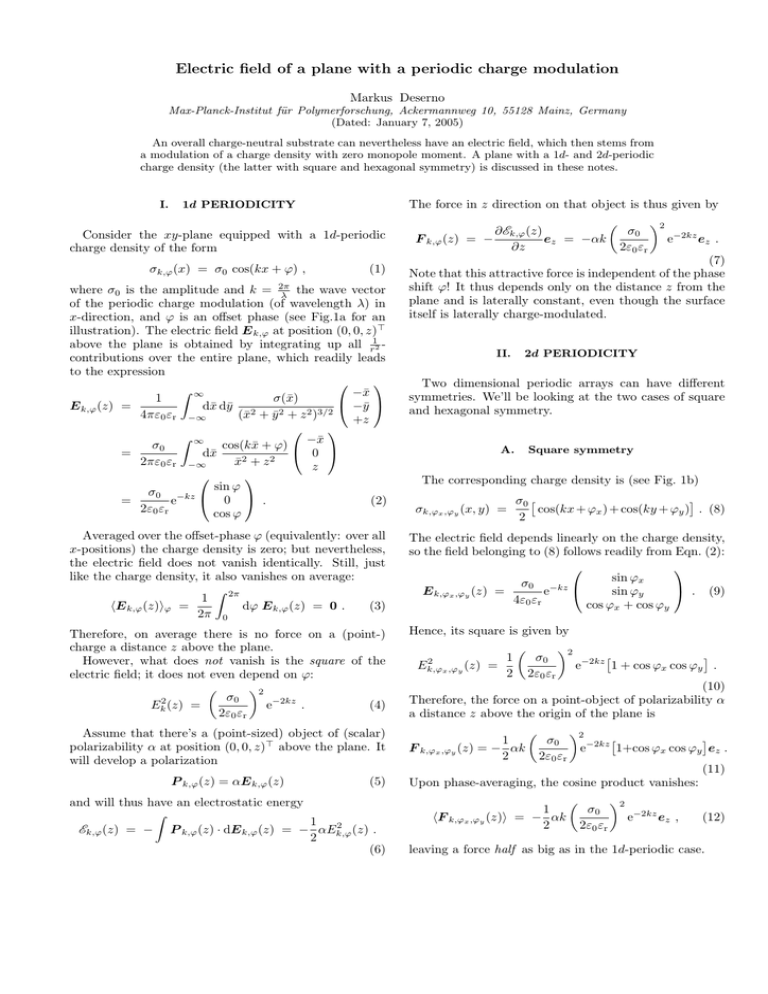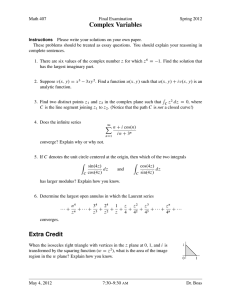Electric field of a plane with a periodic charge modulation
advertisement

Electric field of a plane with a periodic charge modulation Markus Deserno Max-Planck-Institut für Polymerforschung, Ackermannweg 10, 55128 Mainz, Germany (Dated: January 7, 2005) An overall charge-neutral substrate can nevertheless have an electric field, which then stems from a modulation of a charge density with zero monopole moment. A plane with a 1d- and 2d-periodic charge density (the latter with square and hexagonal symmetry) is discussed in these notes. I. The force in z direction on that object is thus given by 1d PERIODICITY Consider the xy-plane equipped with a 1d-periodic charge density of the form σk,ϕ (x) = σ0 cos(kx + ϕ) , (1) where σ0 is the amplitude and k = 2π λ the wave vector of the periodic charge modulation (of wavelength λ) in x-direction, and ϕ is an offset phase (see Fig.1a for an illustration). The electric field E k,ϕ at position (0, 0, z)> above the plane is obtained by integrating up all r12 contributions over the entire plane, which readily leads to the expression Z ∞ −x̄ 1 σ(x̄) −ȳ E k,ϕ (z) = dx̄ dȳ 2 4πε0 εr −∞ (x̄ + ȳ 2 + z 2 )3/2 +z Z ∞ σ0 cos(kx̄ + ϕ) −x̄ 0 dx̄ = 2πε0 εr −∞ x̄2 + z 2 z sin ϕ σ0 −kz 0 . = e (2) 2ε0 εr cos ϕ ∂Ek,ϕ (z) ez = −αk F k,ϕ (z) = − ∂z µ σ0 2ε0 εr ¶2 e−2kz ez . (7) Note that this attractive force is independent of the phase shift ϕ! It thus depends only on the distance z from the plane and is laterally constant, even though the surface itself is laterally charge-modulated. II. 2d PERIODICITY Two dimensional periodic arrays can have different symmetries. We’ll be looking at the two cases of square and hexagonal symmetry. A. Square symmetry The corresponding charge density is (see Fig. 1b) σk,ϕx ,ϕy (x, y) = ¤ σ0 £ cos(kx + ϕx ) + cos(ky + ϕy ) . (8) 2 Averaged over the offset-phase ϕ (equivalently: over all x-positions) the charge density is zero; but nevertheless, the electric field does not vanish identically. Still, just like the charge density, it also vanishes on average: Z 2π 1 dϕ E k,ϕ (z) = 0 . (3) hE k,ϕ (z)iϕ = 2π 0 The electric field depends linearly on the charge density, so the field belonging to (8) follows readily from Eqn. (2): sin ϕx σ0 −kz . (9) sin ϕy E k,ϕx ,ϕy (z) = e 4ε0 εr cos ϕ + cos ϕ Therefore, on average there is no force on a (point-) charge a distance z above the plane. However, what does not vanish is the square of the electric field; it does not even depend on ϕ: µ ¶2 σ0 2 Ek (z) = e−2kz . (4) 2ε0 εr Hence, its square is given by Assume that there’s a (point-sized) object of (scalar) polarizability α at position (0, 0, z)> above the plane. It will develop a polarization P k,ϕ (z) = αE k,ϕ (z) (5) and will thus have an electrostatic energy Z 1 2 (z) . Ek,ϕ (z) = − P k,ϕ (z) · dE k,ϕ (z) = − αEk,ϕ 2 (6) x 2 (z) = Ek,ϕ x ,ϕy 1 2 µ σ0 2ε0 εr ¶2 y £ ¤ e−2kz 1 + cos ϕx cos ϕy . (10) Therefore, the force on a point-object of polarizability α a distance z above the origin of the plane is 1 F k,ϕx ,ϕy (z) = − αk 2 µ σ0 2ε0 εr ¶2 £ ¤ e−2kz 1+cos ϕx cos ϕy ez . (11) Upon phase-averaging, the cosine product vanishes: 1 hF k,ϕx ,ϕy (z)i = − αk 2 µ σ0 2ε0 εr ¶2 e−2kz ez , (12) leaving a force half as big as in the 1d-periodic case. 2 4 4 4 2 2 2 0 0 0 -2 -2 -2 -4 -4 -4 -2 0 a) 2 4 -4 -4 -2 0 2 4 b) -4 -2 0 4 2 c) FIG. 1: Illustration of the planar charge densities discussed in these notes. From left to right we have: a) the one-dimensional density, (1), b) the two-dimensional charge density with square symmetry, (8), and c) the two-dimensional charge density with hexagonal symmetry, (14). In all cases we have k = 2π and all phases are zero. B. Hexagonal symmetry The charge density now corresponds to a superposition of three one-dimensional periodic charge densities, belonging to the wave vectors k i = k n̂i , with the unit vectors n̂i pointing into the direction of the wave front. A hexagonal array results from giving them mutual angles of 120◦ , i. e. µ ¶ µ ¶ µ ¶ 1 1 −1 1 −1 √ √ , n3 = , n1 = , n2 = 2 3 2 − 3 0 (13) resulting in the charge density (see Fig. 1c) ¤ £ σ0 n (14) σk,ϕ1 ,ϕ2 ,ϕ3 (x, y) = cos kx + ϕ1 3 √ £ ¤ + cos k(−x + 3 y)/2 + ϕ2 √ £ ¤o + cos k(−x − 3 y)/2 + ϕ3 . As we see from Eqn. (9), the electric field has some exponential prefactor, a cosine term from each wave in the z component and a sine-term in the xy component into the direction of the wave. Hence, without doing the integral, we can immediately write down what the field of the hexagonal charge distribution (14) has to be: E k,ϕ1 ,ϕ2 ,ϕ3 (z) = 1 sin ϕ√ 1 − 2 (sin ϕ2 + sin ϕ3 ) σ0 −kz 1 .(15) e 2 3(sin ϕ2 − sin ϕ3 ) 6ε0 εr cos ϕ1 + cos ϕ2 + cos ϕ3 Hence, it’s square is given by ¶2 µ σ0 1 = e−2kz × 3 2ε0 εr ½ i 1h cos(ϕ1 + ϕ2 ) + cos ϕ1 cos ϕ2 1+ 3 i cos(ϕ2 + ϕ3 ) + cos ϕ2 cos ϕ3 2 (z) Ek,ϕ x ,ϕy cos(ϕ3 + ϕ1 ) + cos ϕ3 cos ϕ1 i¾ . (16) This again depends in some awkward way on the three phases. However, upon averaging over them, all the cosine terms vanish. Hence, in analogy to Eqn. (12), we obtain an average force, given by 1 hF k,ϕ1 ,ϕ2 ,ϕ3 (z)i = − αk 3 µ σ0 2ε0 εr ¶2 e−2kz ez , (17) which is one third as strong as in the 1d-periodic case. III. MORAL If one comes across an exponentially decaying force on a polarizable point source which displays a characteristic decay length ` = 1/2k, this would correspond within the present scenario to a 1d or 2d surface charge modulation with a wavelength λ = 4π`. In order to check the symmetry, one would have to measure the phases.




